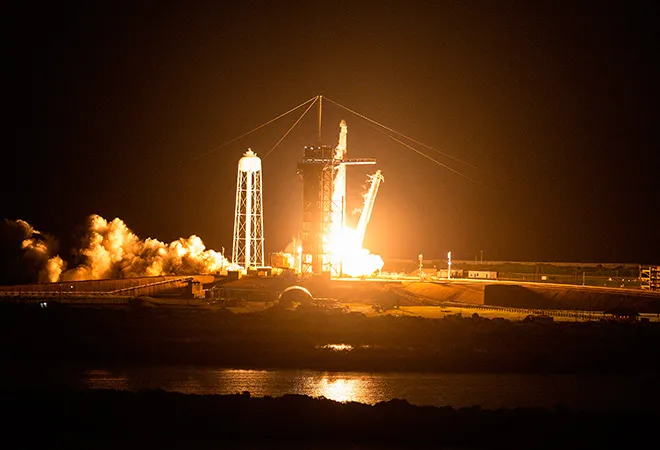
There is a
central governance challenge in the space domain, marked today by a new generation of players and technologies: How do we build safe, secure, and reliable practices in and through space for all public and private stakeholders around the world? In a world that has returned to great power competition, there are three principal challenges to this endeavour—incentives, rivalry, and alliances.
One set of challenges comes from the dual-use nature of space technology, and the structural incentives facing their makers in uncertain markets. This is not always evident when we see awe-inspiring innovations unfolding—rockets that now go up and come back down, diverse payloads on dedicated rideshare missions, satellites that can track and map human activities virtually everywhere on the planet, mega constellations beaming internet back down to bridge the digital divides between the rich and poor, nuclear propulsion that may take the first humans to Mars and beyond, and so on.
But despite rosy
projections that the space economy might go from over US $400 billion today to US $3-4 trillion in the near future, no one knows how many of the exciting new companies, innovations, or niches will actually turn out to be commercially profitable. But it is reasonably foreseeable that these actors and their technologies can be morphed into the service of national space security architectures. This is already underway, skewing space trajectories towards militarisation. Companies have strong incentives to go after civilian and defense contracts which, despite ups and downs, represent a
sizeable market for the new space players (like SpaceX), just like the old ones (like Boeing, Lockheed Martin).
Corporate incentives to militarise—and even openly weaponise—products and services are fortified in the great power competition. A formidable second set of challenges for thinking about, defining, and building cooperative frameworks stems from the strategic rivalry between the United States (US) and China.
Historical experience points to this trajectory, and the hardening rhetoric and postures of both powers confirm that they see space as a warfighting domain.
Corporate incentives to militarise—and even openly weaponise—products and services are fortified in the great power competition. A formidable second set of challenges for thinking about, defining, and building cooperative frameworks stems from the strategic rivalry between the United States (US) and China
Their great power competition extends to, in, and through space. Virtually every core technology related to or at the nexus of space represents a set of capabilities to gain an edge over a rival. It is
naïve to imagine anything else, as countries trumpet worthy civilian and commercial goals such as servicing satellites, de-orbiting orbital debris, flying solid-fuel rockets, or landing on the far side of the moon. Small satellites, for example, are seen as critical for resiliency in space security architectures today, which means that
military intelligence, national intelligence, and defense budgets are moving in their direction.
Such technologies may certainly have scientific and commercial values, but their military uses and implications are clear and present. How they intersect with nuclear, cyber, electromagnetic, Artificial Intelligence (AI), and quantum frontiers matters foundationally for great power status and their cross-domain operations. They are fundamental to balancing defensive and offensive strategies, especially when generals both in the
US and
China see warfighting in space as all but inevitable.
As they affect the balance of power, this also means the technologies are tough to police, much less regulate across rivalrous nations. Restraints over both
kinetic and non-kinetic anti-satellite (ASAT) testing are melting away, as one example. The kinetic assets are the most visible, as demonstrated in anti-satellite tests by China (2007), the US (2008), and most recently India (2019). But
the non-kinetic targeting of sensors and data involving space assets—lasers, jamming cyberattacks, and so on—gets far less attention.
Since it is difficult to define a space weapon or distinguish cleanly between civilian-military fusion,
most state-of-the-art counterspace capabilities can also go unremarked. Japan’s second Hayabusa mission to an asteroid did what its predecessor could not—shoot a copper “bullet” into the surface of an asteroid at 300 metres per second. That is a credible signal of counterspace capabilities – what the country can see, do, and endure over huge distances. But who was it meant to persuade and for what?
This brings us to the third set of challenges that affect the prospects of building stable practices: The bipolarity of alliances in space. On the one side, there is the US-led space order consisting of both formal and informal moves with allies like Japan, the special relationship with the UK, longstanding NATO, and newfound QUAD partners. On the other side is China, with a newly-minted lunar pact with Russia and the all-weather relationship with Pakistan, which is anchoring its space information corridor in the customer base of its Belt-and-Road Initiative. These alignments are not clear cut or necessarily stable—votes are not always aligned as expected, partners could join projects in both camps, and preserving economic and trade relations may be a priority.
Still, the deepening bipolarity shows up when one side or the other attempts to influence the principled basis for space operations on a global basis. Then it matters who and how many sign up, and whether they are supportive of some underlying norms and standards and ways of thinking. The process of bringing in allies and partners affects the chances of institutionalising norms and principles, and will matter over the long run for power projection.
Since 2008, Russia and China have been urging a
Treaty on the Prevention and Placement of Weapons in Outer Space under the auspices of the Conference on Disarmament at the United Nations. The draft treaty has been criticised for
leaving issues unresolved and has not gained traction,
especially on the US side. The US meanwhile has advanced the
Artemis Accords with a core (and expanding) set of countries, attempting to diplomatically infuse prospects for civil space exploration with principles of due regard and harmful interference in “safety zones.” This process has
drawn controversy from some quarters for advancing and privileging US interpretations of international space law going forward. The US military has also thrown its weight behind the principles of operating with due regard for others and avoiding harmful interference, part of its
tenets for responsible behavior in space.
Given where we are, it may well be that the partners of and not the great powers themselves may end up shaping the prospects for building and spreading safe and reliable practices. But the backing of great powers will still matter.
For now, the UK is playing a significant leadership role in space diplomacy, which is an important avenue to watch. The US and its allies are backing a long-running initiative spearheaded by the UK—a resolution on reducing space threats through norms, rules, and principles of responsible behaviors that was adopted by the UN General Assembly
For now, the UK is playing a significant leadership role in space diplomacy, which is an important avenue to watch. The
US and its allies are backing a long-running initiative spearheaded by the UK—a resolution on reducing space threats through norms, rules, and principles of responsible behaviors that was
adopted by the UN General Assembly. The UK has also tabled another UN draft resolution to set up an Open Ended Working Group to build consensus on restraining threatening actions in space through voluntary means—
a process and objective the US reportedly intends to support. Whether the UK can work to forge some basic consensus between the US and China through its other initiatives—
as it is steadily attempting to do—remains to be seen.
The views expressed above belong to the author(s). ORF research and analyses now available on Telegram! Click here to access our curated content — blogs, longforms and interviews.



 There is a
There is a  PREV
PREV


